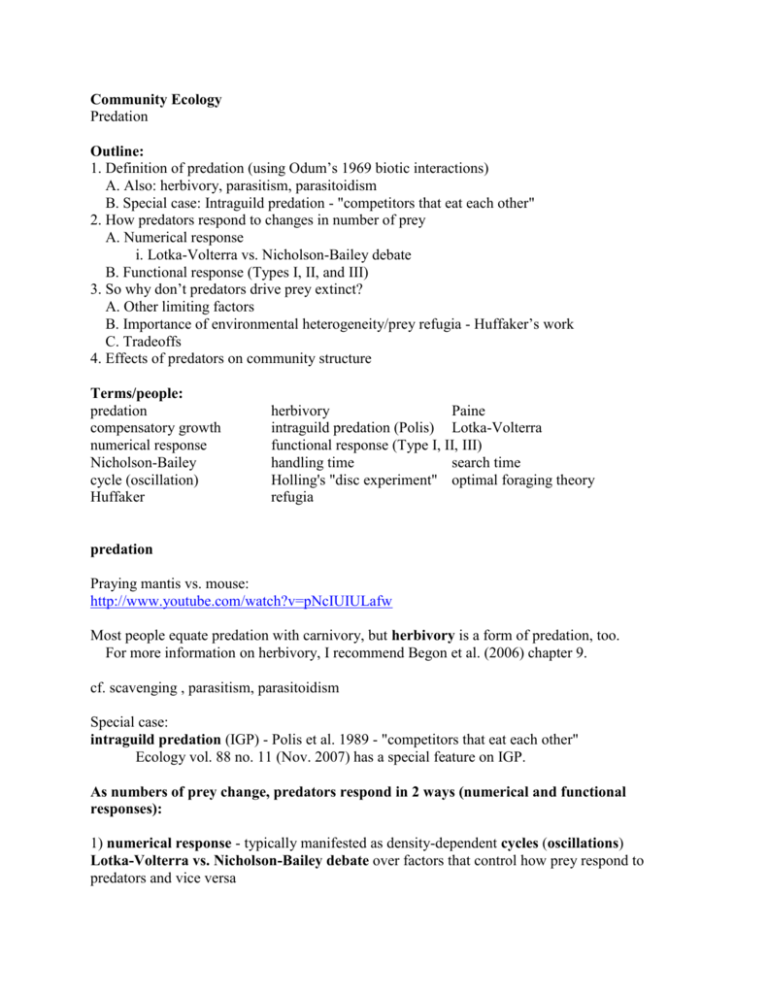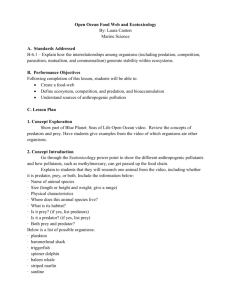Predation
advertisement

Community Ecology Predation Outline: 1. Definition of predation (using Odum’s 1969 biotic interactions) A. Also: herbivory, parasitism, parasitoidism B. Special case: Intraguild predation - "competitors that eat each other" 2. How predators respond to changes in number of prey A. Numerical response i. Lotka-Volterra vs. Nicholson-Bailey debate B. Functional response (Types I, II, and III) 3. So why don’t predators drive prey extinct? A. Other limiting factors B. Importance of environmental heterogeneity/prey refugia - Huffaker’s work C. Tradeoffs 4. Effects of predators on community structure Terms/people: predation compensatory growth numerical response Nicholson-Bailey cycle (oscillation) Huffaker herbivory Paine intraguild predation (Polis) Lotka-Volterra functional response (Type I, II, III) handling time search time Holling's "disc experiment" optimal foraging theory refugia predation Praying mantis vs. mouse: http://www.youtube.com/watch?v=pNcIUIULafw Most people equate predation with carnivory, but herbivory is a form of predation, too. For more information on herbivory, I recommend Begon et al. (2006) chapter 9. cf. scavenging , parasitism, parasitoidism Special case: intraguild predation (IGP) - Polis et al. 1989 - "competitors that eat each other" Ecology vol. 88 no. 11 (Nov. 2007) has a special feature on IGP. As numbers of prey change, predators respond in 2 ways (numerical and functional responses): 1) numerical response - typically manifested as density-dependent cycles (oscillations) Lotka-Volterra vs. Nicholson-Bailey debate over factors that control how prey respond to predators and vice versa L-V 1920s: rate of prey removal is a function of both predator and prey pop. numbers For prey: dV/dt = rV - VP where V=victim (prey), P=predator, r=rate of increase of prey, e=encounter rate (larger is, the more a single predator can depress prey; for example, a baleen whale feeding on krill would have a very large because a single whale can eat millions of krill at once) For predator: dP/dt = VP - qP where V=victim (prey), P=predator, =conversion efficiency (rate at which predator converts victim biomass into new predator offspring; is high when a single prey item is very valuable, e.g. when a large bison is killed by wolves, is small when a single prey item isn’t worth much, e.g. a single seed to a granivorous bird), q=death rate of predator As with L-V competition models, L-V predation models can be graphed as number of predators (P) vs. number of prey (V), with vertical (dP/dt = 0) and horizontal (dV/dt = 0) isoclines representing critical minimal levels of prey necessary to sustain the predator population and levels of predators that exert control over the prey, respectively. The two isoclines cross, dividing the state-space graph into 4 quadrants. The net vectors of each quadrant make the overall graph assume a counterclockwise form of overall coexistence (oscillation). N-B 1930s: proposed alternative to L-V (criticized L-V because it is oversimplified and unrealistic, especially with regard to the tenet that the number of prey caught increases in direct proportion to the number of predators; surely, said N-B, as predators increase they exhibit some interference on each other [e.g. getting in the way of each other, flushing prey] that reduces overall efficiency) - as number of predators increases, the rate of attack on prey increases steeply at first and then less rapidly as predators run out of prey and start encountering other predators instead of prey; like L-V, rate of prey removal is a fct of predator and prey pop. numbers, but unlike L-V, there eventually comes a time when predator numbers start interfering with prey consumption, so it’s not simply a case of as prey goes up, predation goes up (can actually go down because of interference). Unlike L-V, N-B dynamics do not predict stable cycles (oscillations). Both L-V and N-B scenarios have been observed in the lab and/or field. There are many possible variations on the models (e.g. inclusion of carrying capacities, densitydependent effects, etc.). See Gotelli (2001) for more details. 2) functional response (Holling 1959) - as prey increases, each individual predator may take more prey or take prey sooner; 3 types (see Fig. 5.3 in Mittelbach text): Type I Type II - Fig. 5.4 in Mittelbach text Holling’s disc exercise with "searching time" and "handling time" - A (classic comedy) example of handling time: http://www.youtube.com/watch?v=8NPzLBSBzPI Type III switching search image "threshold of security" So why don’t predators always "win" and drive prey extinct??? Huffaker (1958) Predator-prey evolutionary arms race (newts and snakes): http://www.pbs.org/wgbh/evolution/library/01/3/l_013_07.html Effects of predators on community structure: - selective (specialist) predators may increase diversity if preferred prey is a competitively dominant spp. (e.g. Paine 1969) - effects of generalist predators are more difficult to predict (if prey attacked in proportion to their abundance, then most abundant/dominant spp. will be taken, which will incr. div. by suppressing dominants) - intermediate levels of predation ≈ intermediate disturbance hypothesis (can increase diversity) - predators more likely to have an impact in an area that is relatively stable (not disturbed) bc in disturbed areas, disturbance hammers predators and prey alike (Menge and Sutherland 1976) - predators can facilitate coexistence of multiple species that pairwise comparisons would predict are unstable (Caswell 1978) - I highly recommend William Stolzenburg’s (2008) book for information on what happens when predators are eliminated from a community. Like competition, predation is a more complex subject than we have time to cover see chapters 5-8 in Mittelbach text for more information (and on individual and population responses, not just community responses) Next lecture: parasitism and mutualism References: Ecology 88(11) from Nov. 2007 has a special feature on intraguild predation. Begon, M., C.R. Townsend, and J.L. Harper. 2006. Ecology: From Individuals to Ecosystems. Blackwell Publ., Malden, MA. Bond, A.B., and A.C. Kamil. 1998. Apostatic selection by blue jays produces balanced polymorphism in virtual prey. Nature 395: 594-596. Caswell, H. 1978. Predator mediated coexistence: a nonequilibrium model. Am. Nat. 112:127154. Gotelli, N.J. 2001. A Primer of Ecology, 3rd ed. Sinauer Associates, Inc., Sunderland, MA. Holling, C.S. 1959. The components of predation as revealed by a study of small mammal predation of the European pine sawfly. Can. Entomol. 91:293-320. Huffaker, C.B. 1958. Experimental studies on predation: dispersion factors and predator-prey oscillations. Hilgardia 27:343-383. McNaughton, S.J. 1979. Grassland-herbivore dynamics. Pp. 46-81 in: Serengeti: Dynamics of an Ecosystem (A.R.E. Sinclair and M. Norton-Griffiths, eds.). University of Chicago Press, Chicago, IL. Menge, B., and J.P. Sutherland. 1976. Species diversity gradients: synthesis of the roles of predation, competition, and temporal heterogeneity. Am. Nat. 110:351-369. Nicholson, A.J., and V.A. Bailey. 1935. The balance of animal populations, part I. Proc. Zool. Soc. Lond. 3:551-598. Polis, G.A., C.A. Myers, and R.D. Holt. 1989. The ecology and evolution of intraguild predation: potential competitors that eat each other. Annu. Rev. Ecol. Syst. 20:297-330. Sinclair, A.R.E. 1985. Does interspecific competition or predation shape the African ungulate community? J. Anim. Ecol. 54:899-918. Spiller, D.A., and T.W. Schoener. 1989. An experimental study of the effects of lizards on webspider communities. Ecol. Monogr. 58:57-77. Stolzenburg, W. 2008. Where the Wild Things Were: Life, Death, and Ecological Wreckage in a Land of Vanishing Predators. Bloomsbury, New York, NY. Tansley, A.G., and R.S. Adamson. 1925. Studies of the vegetation of the English chalk. III. The chalk grasslands of the Hampshire-Sussex border. J. Ecol. 13:177-223. Volterra, V. 1926. Fluctuations in the abundance of a species considered mathematically. Nature 118:558-560.









